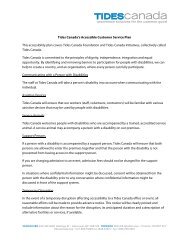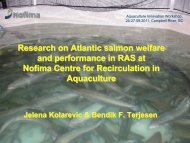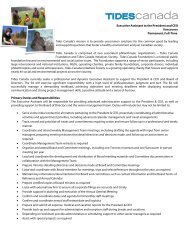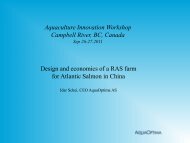Entrepreneurial Solutions to Insoluble Problems - Tides Canada
Entrepreneurial Solutions to Insoluble Problems - Tides Canada
Entrepreneurial Solutions to Insoluble Problems - Tides Canada
- No tags were found...
You also want an ePaper? Increase the reach of your titles
YUMPU automatically turns print PDFs into web optimized ePapers that Google loves.
Growing OpportunityDeeper Dive: EnergyNot only are billions ofpeople denied reasonableenergy services, but theplanet is running a feversimply by meeting theneeds of those who arecurrently served.91www.innovalight.com/index.html92www.rmi.org93www.mbdc.com94www.mcdonoughpartners.com95www.hypercar.comMindset 3.0In carrying out this Deeper Dive, we spoke<strong>to</strong> a range of companies and organizations,from big petrochemical companies through<strong>to</strong> early stage start-ups like Innovalight. 91This is a fascinating Silicon Valley start upwhich is using nanotechnology and siliconinks <strong>to</strong> create ultra-low-cost solarpho<strong>to</strong>voltaic modules. It has developed asilicon nanocrystalline ink that could cutthe cost of flexible solar panels <strong>to</strong> a tenthof current solar cell solutions — using asolvent-based silicon process that lendsitself <strong>to</strong> low-cost production and highthroughputmanufacturing. Just one moreexample of the cleantech surge nowbuilding. But in what follows, we will drawon the experience of the full spectrum ofnon-profit <strong>to</strong> for-profit organizations, fromfoundation-funded social enterprises <strong>to</strong>market-driven cleantech ventures.Standing back, what these entrepreneurshave <strong>to</strong> teach the wider world has less <strong>to</strong>do with how <strong>to</strong> develop a given technologyor how <strong>to</strong> put <strong>to</strong>gether a particular product,than with how they think, act and lead.So, for anyone wondering where theMindset 3.0 agenda (Figure 3.1, page 24)might take us, here are five points whichstruck us in looking over the shoulders ofdifferent types of entrepreneur working inthe energy field.1 Systems thinking and design:inefficiency is the enemyOne striking thing about leading social andenvironmental entrepreneurs is that theyare dedicated <strong>to</strong> changing the system, notjust <strong>to</strong> making marginal improvements.Whether or not they succeed in suchambitious aims is quite another matter,but there is no question that the globalenergy system is dysfunctional: not onlyare billions of people denied reasonableenergy services, but the planet is runninga fever simply by meeting the needs ofthose who are currently served.Take a taxi example. Jim Harris, ManagingPartner with the evolving CleantechInnovation Institute, is working out how<strong>to</strong> get those who influence choices on whatsort of vehicles qualify as taxis — the au<strong>to</strong>makers,taxi companies, leasing companies,regula<strong>to</strong>ry agencies, insurers and others —<strong>to</strong> focus on changing Toron<strong>to</strong>’s (and then<strong>Canada</strong>’s and then North America’s) taxis<strong>to</strong> hybrid propulsion systems.41‘Converting North America’s 200,000taxis <strong>to</strong> hybrids,’ he explains, ‘would havetremendous financial, economic, health,and environmental benefits. Hybrid carsreduce smog emissions by more than 70%.Taxis drive 10 times the distance of averagevehicles every year. Changing 200,000taxis <strong>to</strong> hybrids would have the sameimpact as converting 2,000,000 cars!’The uncoupling of GDP from energyconsumption — shown in Figure 5.5 —is by no means a foregone conclusion: ithas <strong>to</strong> be fought for every step of the way.That’s what makes the work of people likeAmory Lovins (of the Rocky MountainInstitute 92 ) and Bill McDonough (of MBDC93and William McDonough + Partners 94 )so important. Whether or not particulardesigns like Lovins’ hypercar 95 (designed <strong>to</strong>achieve a three- <strong>to</strong> five-fold improvementin fuel efficiency) actually get built anytime soon, the spotlight has been placedsquarely on the need <strong>to</strong> drive out energyfrom our economies, value chains andbusinesses.2 Emerging economies:use bigger BRICsGiven the scale of the energy demand ofthe BRIC economies (Brazil, Russia, India,China) and other emerging markets, theworld needs <strong>to</strong> focus its attention here —and as soon as possible. Bill McDonoughhas already been working on a number ofplanned eco-cities there, an opportunityspace that has also attracted EcoCities. 96Ask the organization’s Chairman, LawrenceBloom, why he is focusing on China, and heis very clear on the point. ‘Fundamentally,the first EcoCities project is under way inChina (in Dongtan, near Shanghai) becausethe first opportunity was created there.’He explains, ‘China has both the “stick” and“carrot” in large measure <strong>to</strong> drive her fromher present polluting paradigm <strong>to</strong> cleanerand more secure solutions. Currently, onedirty coal power station comes on streamevery eight days <strong>to</strong> fuel China’s continuingeconomic growth. When I was last inBeijing, we <strong>to</strong>ok off from Beijing CapitalInternational airport on a cloudless day,but could not see the sun until the planewas at 12,500 feet. The pollution is nearlytwo-and-a-half miles high and is currentlyconsidered <strong>to</strong> be costing the country 8%of GDP in asthmatic and bronchialconditions and lost working days. With400 million people expected <strong>to</strong> migratefrom the countryside <strong>to</strong> the cities in thenext 30 years, that is a very big stick.’
















